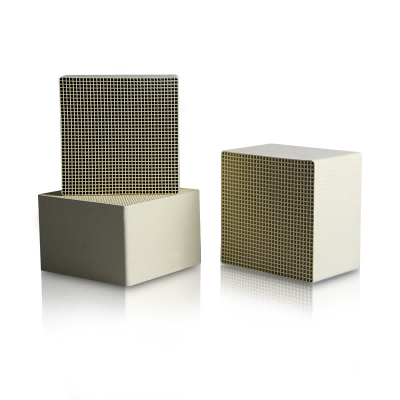Yuanchen Technology: Introduction to various carrier series SCR denitration catalysts (V)
Oct 27, 20221) Pana et al [20] prepared a 20% (mass fraction, same below) loaded MnOx/TiO2 denitrification catalyst by impregnation method, and the catalytic performance evaluation showed that the denitrification rate could reach 100% at 120°C at 8000 h-1 air speed. The activity evaluation results showed that the Mn metal on the TiO2 carrier was highly dispersed when the Mn content was less than 16.7%, and the activity of the denitrification catalyst varied with the Mn loading, and the Mn/TiO2 denitrification catalyst showed the highest catalytic activity at 175°C with the Mn loading of 16.7%, and the NO conversion was 94%. MnOx/TiO2 denitrification catalysts were prepared by Jiang et al [22] using impregnation, sol-gel and co-precipitation methods, and the MnOx/TiO2 denitrification catalysts prepared by sol-gel method showed the highest catalytic activity and better SO2 resistance at low temperature, and the denitrification rate reached 90% at 145 °C; Zhang et al [23] used ultrasonic impregnation to prepare MnO2/TiO2 denitrification catalysts, which had higher SCR catalytic activity compared with the conventional impregnation and sol-gel-suspect methods, especially in the low temperature range below 120 °C. The higher catalytic activity of the denitrification catalysts could be attributed to the strong synergistic interaction between Mn and Ti, the large specific surface area, the high concentration of hydroxyl groups, the high amorphous Mn content, the large number of Lewis acid sites, etc.

2) As with unloaded Mn denitration catalysts, the addition of transition metals can improve the active metal dispersion of MnOx/TiO2 denitration catalysts, form solid solutions with MnOx and TiO2, increase the catalytic activity and acid resistance of denitration catalysts by specific surface area, and reduce the catalytic reaction temperature window. The addition of oxide to MnOx/TiO2 denitration catalyst can improve the catalytic activity and N2 selectivity of low-temperature SCR reaction and enhance its resistance to H2O and SO2; Wu et al [25-26] found that the addition of Ce can significantly improve the denitration catalyst activity, effectively improve the resistance to SO2 and inhibit the formation of sulfate on the surface of denitration catalyst; Jin Ruiben [27] carried out the Mn/TiO2 denitration catalyst on the The doping of metallic elements on the Mn/TiO2 denitration catalyst showed that the doping of Ce could significantly improve the low temperature SCR activity of the denitration catalyst (the NO conversion rate at 100 °C increased from 62% to about 95%), and the addition of Ce could enhance the oxygen storage capacity and surface acidic sites of the denitration catalyst, thus promoting the adsorption and activation of NH3 on the surface of the denitration catalyst. Thirupathi et al [28] found that the addition of Ni could enhance the formation of MnO2 phase and inhibit the formation of Mn2O3 sites on the surface, and could improve the catalytic activity of MnOx/TiO2 denitration catalyst for low temperature SCR reaction.